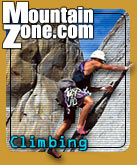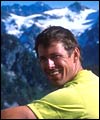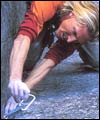
The Instant Classic: Fifty Favorite Climbs
Mark Kroese's new guide book reflects the breadth and individuality of climbing at the millennium
November 27, 2001
|
||
The result is Fifty Favorite Climbs (The Mountaineers Books, Seattle, 2001), released just this summer but already a Banff Mountain Book Festival award winner and a favorite of many climbers. The lavishly illustrated guidebook includes interviews with 50 of the world's most accomplished currently active climbers, with a comprehensive guide to each one's favorite climb. The combination of great photography, armchair read and serious utility has proven to be the right one for Kroese (pronounced 'Cruz').
| " These days there
are many more climbing areas, many more good climbs, many more climbers, and
massive specialization.... What a daunting task it would be to cover all
that in one book." |
|||||
"Then I got busy with life and career and family and all that," Kroese explained, "but in 1995 I started doing harder climbs. I picked up that book again in '98 and realized it was a great book for its day, but here we are almost 20 years later. It seemed dated. I knew somebody should come up with a new version. But, I thought, what a task that would be! These days there are many more climbing areas, many more good climbs, many more climbers, and massive specialization--ice climbers, mixed climbers, alpine climbers, trad rock climbers, sport climbers. What a daunting task it would be to cover all that in one book."
|
||
"That was really the idea-to take myself, my biases and opinions, and, frankly, my limited knowledge and experience out of the equation, and get the collective knowledge of the best climbers around; the climbers who are putting up the best routes."
Publishers were interested, but there was one consistent point of skepticism: great idea, the publishers told him, but who's going to get an audience with all these climbers? Who can realistically expect to meet with the world's top-50 climbers? Fifty is a big number these guys are busy, and...who are you anyway?
"Frankly," conceded Kroese, "These were the same questions I was asking myself."
Kroese, convinced he could pull it off, came up with a set of parameters that would enable him to cover the gamut of climbs and climbers.
"At that beginning stage I saw myself more in the role of an editor than a writer," Kroese said, "choosing a cross section of climbers who represented a continuum of points of view and experiences. I wanted everything from the guy who said. 'If you're not going from bolt to bolt on a sport climb, you're not trying hard enough,' to the guy who said, 'Hey, onsite climbing is all that matters.' I wanted that range, but I also wanted to avoid redundant points of view. For example, people have said to me, 'Hey, why isn't Paul Piana in the book?' Piana is a great climber, but he's kind of a lot like Todd Skinner. And at the risk of generalizing, they kind of stand for the same thing, they have the same perspective. So for the sake of the book, I could really only include one of them."
Other criteria applied to the selection of climbers for the book included diversity, in geography, style, gender and approach. And, perhaps most important, all the climbers would have to be currently active.
"The bottom line is that every climber had to be active, currently active. This is not a book about legendary pioneers of yesteryear, such as Chouinard, guys like that. It's about people climbing today," Kroese said.
Next, the author set about the laborious process of figuring out just who should be in a book like that.
| " To my mind, Croft, mentally and physically, is simply in a different league
by several orders of magnitude. I was awestruck by his abilities..." |
|||||
After he had done the up-front work, all that was left was to contact the climbers, explain what he was trying to do, and see what the reactions would be.
"In the end," Kroese said, "I knew that the decision on whether or not to participate was up to the climbers themselves. If they didn't want to, there wouldn't be much I could do about that."
Kroese admits that his task got easier once he had commitments from high-profile climbers such as Alex Lowe and Lynn Hill, which put other climbers more at ease about participating. Only two climbers turned down the opportunity, one saying he already was over-committed, another for a legal reason. With his roster of climbers finalized, Kroese set about working with each one to write up the climb each called a favorite.
"I never tried to steer people to certain climbs, or impose my biases on them," said Kroese. "I left the decision to them. There were a few times that people said there were several climbs they wanted to choose as their favorites, so I'd sort of say, 'Well, let's do this one.' For instance, I was really hoping someone would choose a climb at Squamish (British Columbia). And Russ Clune came to me and said he had three favorites: One was in Zion, which already was covered by another climber, but another was at Squamish (The Grand Wall), so I said, 'Well, if you're indifferent, let's do the one on Squamish.' So that's the way it went, but in the end I think the book reflects a good geographic mix."
|
||
The final selection of climbs and climbers that appeared in Fifty Favorite Climbs reads like a who's who of North American climbing. Climbers such as Chris Sharma, Hans Florine, Steph Davis, Conrad Anker, Jim Bridwell, Nancy Feagin, Greg Child, Jack Tackle, Tommy Caldwell and Jim Donini sing the praises of climbs as diverse as Stump Spire in Baffin Island, the North Face of the Rostrum in Yosemite, The Obelisk on Colorado's Longs Peak, Cobra Pillar in Alaska, Southeast Face of Mount Proboscis in Canada, Sunlight Buttress in Utah's Zion National Park and VMC Direct Direct in New Hampshire.
The one thing that did surprise the author was how important Yosemite Valley remains in the world of climbing. In that respect, it seemed, little had changed in the quarter century since Fifty Classic Climbs was published.
"The biggest surprise," said Kroese, "was the continued dominance and importance of Yosemite Valley as a favorite venue. One of my criteria is that the climbs could not have been in Fifty Classic Climbs, but despite that fact there are eight of 50 climbs in Yosemite. But its role has changed. In the old days, if you just got up El Cap, that was like, wow. Now if it took you more than eight hours. . . . So climbing El Cap is still an important benchmark, but now it's the style of the climbs, or maybe it might be number of routes on El Cap, or the speed, but it's still an important benchmark.
"I was also surprised by the number of Canadian climbs, and the fact no one picked climbs in the Southeast. But my 500-foot rule might have eliminated some good climbs in that part of the country."
Kroese gives a lot of credit to his publisher for seeing that the book evolved into something bigger than intended.
"The Mountaineers looked at the exceptional quality of the photos," said Kroese, "and took into account that I gave them about 15,000 more words than they asked for, and instead of cutting back they decided to make the book bigger, both in trim size and length. A lot of publishers might not have done that. And with great original images by photographers like Jorge Visser and Topher Donahue, the bigger size really makes a difference."
Meeting 50 people under any circumstance is probably going to be an interesting experience, but to meet 50 of the top climbers in the world was part of the reward for doing the book. He said that he was impressed by many of the people he interviewed for the book, but none more than Peter Croft, the Canadian climber best known for his difficult solo ascents.
"The guy is just cut from a different cloth," Kroese said, shaking his head. "To my mind, Croft, mentally and physically, is simply in a different league by several orders of magnitude. I was awestruck by his abilities, mentally and physically, his strength and fortitude. I was really impressed."
For Kroese, Fifty Favorite Climbs was worth the two years of hard labor he put into it.
"I feel good about it," Kroese said with a smile. "It was hard and, toward the end, I definitely was psyched to be done with it. Dealing one-on-one with each climber was the most rewarding part of the process. In retrospect I see the book as a climb. No single chapter was that hard, but in retrospect I view the process of writing the book as a climb in and of itself. I'd have to rate it A1, grade 7, solo, without enough rope to retreat. It was like, okay, that pitch wasn't too hard, but now it's on to the next one. That makes it a 50-pitch climb.
"The toughest audience was the climbers themselves," Kroese concluded. "What was most satisfying was to have them come up and say, not only do I think you got my part right, but I know most of these other climbers and that's the way I think of them. So to me everything after that is gravy, because they are the ones who know."
Fifty Favorite Climbs is much more than a guide book. The combination of photographs and interviews and route information results in a kind of snapshot of the state of North American climbing here at the millennium. If there's a knock on the book, it has to be that many of the climbs are just too demanding for most weekend climbers.
"I can't deny some of these climbs are pretty hard," Kroese admitted. "The goal I had, my own litmus test, was that I personally should be able to do maybe 40 of the 50 climbs. In the end that number is probably closer to 35 than 40, that with my skill set I would or could do. But in the end, when you ask the best climbers around for their favorite climbs, you're going to get some hard climbs. People should remember the book is as much about climbing areas as it is about specific climbs. Who knows, maybe it will encourage people to get out there and work to climb at a little higher level."
— Peter Potterfield, MountainZone.com Staff



